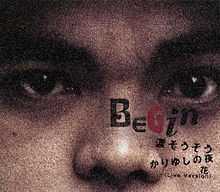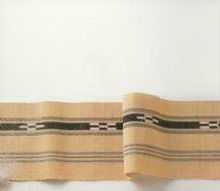Nada Sōsō
| "Nada Sōsō" | |||||||||||||
|---|---|---|---|---|---|---|---|---|---|---|---|---|---|
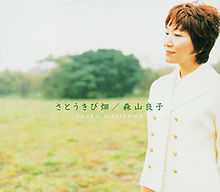 | |||||||||||||
| Single by Ryoko Moriyama | |||||||||||||
| from the album Time Is Lonely | |||||||||||||
| Released |
December 5, 2001 March 12, 2003 (special live version) | ||||||||||||
| Recorded | 1998 | ||||||||||||
| Genre | J-pop, folk song | ||||||||||||
| Length | 4:07 | ||||||||||||
| Label | Dreamusic | ||||||||||||
| Writer(s) | Begin, Ryoko Moriyama | ||||||||||||
| Producer(s) | Koji Igarashi | ||||||||||||
| Ryoko Moriyama singles chronology | |||||||||||||
| |||||||||||||
| |||||||||||||
"Nada Sōsō" (涙そうそう, Great Tears Are Spilling) is a song written by Japanese band Begin and singer Ryoko Moriyama. It was first released by Moriyama in 1998, but achieved popularity through the cover version by Rimi Natsukawa in 2001.
Ryoko Moriyama version
The song first appears in Ryoko Moriyama's discography in 1998, as a track on her album Time Is Lonely, an album which did not even break the top 100 Oricon albums chart.[1]
Moriyama re-released the song as the second A-side of the single "Satōkibi-batake/Nada Sōsō" in 2001, after Rimi Natsukawa's version had become popular. In 2003, a single featuring a special live version featuring Moriyama, Begin and Natsukawa was released.
Background, writing
Moriyama and Begin met after performing at live events together in the late 1990s. Moriyama asked Begin to write her an Okinawan-style song. The song's title on the demo tape she received was "Nada Sōsō," an Okinawan language phrase meaning "large tears are falling" (to compare, the Japanese phrase would be namida ga poroporo kobore ochiru (涙がぽろぽろこぼれ落ちる)). When Moriyama found out the meaning of the phrase, it reminded her of the death of her older brother.[2] She kept the title, and based the lyrics she wrote around these feelings.
The lyrics speak of looking through an old photo-book at pictures of somebody who has died. The protagonist of the song is thankful to them for always encouraging them, and for being happy no matter what. They believe they will meet them again one day, and cries as they send thoughts of sadness and love to that person.[3]
Track listing
Satōkibi-batake/Nada Sōsō
All songs arranged by Koji Igarashi.
| No. | Title | Lyrics | Music | Length | |
|---|---|---|---|---|---|
| 1. | "Satōkibi-batake (さとうきび畑 Sugarcane Field)" | Naohiko Terashima | Naohiko Terashima | 10:20 | |
| 2. | "Nada Sōsō" | Ryoko Moriyama | Begin | 4:10 | |
Total length: |
14:30 | ||||
Special live version
| No. | Title | Lyrics | Music | Length | |
|---|---|---|---|---|---|
| 1. | "Nada Sōsō (Special Live Version) (with Begin, Rimi Natsukawa)" | Ryoko Moriyama | Begin | 4:23 | |
| 2. | "Satōkibi-batake (Yano Rabo Version) (さとうきび畑 Sugarcane Field) (with Akiko Yano)" | Naohiko Terashima | Naohiko Terashima | 6:59 | |
Total length: |
11:27 | ||||
Chart rankings
| Release | Chart | Peak Position | First Week Sales | Sales Total | Chart Run |
|---|---|---|---|---|---|
| December 5, 2001 March 12, 2003 |
Oricon Daily Singles Chart | ||||
| Oricon Weekly Singles Chart | 18 32 |
2,380 3,459 |
127,585 32,848 |
57 weeks 23 weeks | |
| Oricon Yearly Singles Chart |
Begin version
| "Nada Sōsō" | |||||||
|---|---|---|---|---|---|---|---|
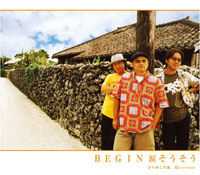 | |||||||
| Single by Begin | |||||||
| from the album Begin no Shima Uta (Omato-take O) and Begin | |||||||
| B-side | Kariyushi no Yoru, Hana (Live Version) | ||||||
| Released | March 23, 2000 | ||||||
| Genre | J-pop, Shima uta | ||||||
| Length | 4:00 | ||||||
| Label | Teichiku Records | ||||||
| Begin singles chronology | |||||||
| |||||||
| |||||||
Begin released a self-cover of the song as the band's 18th single on March 23, 2000. It appears on two 2000 albums by Begin: their Okinawan concept album Begin no Shima Uta (Omato-take O) and a regular studio album, Begin. Two versions backed with sanshin appear on Begin no Shima Uta (Omato-take O) (one in Japanese, one in Okinawan), while the regular studio version appears on Begin (and is backed with acoustic guitar and strings).
Begin's version of the song was used as the theme song of Marvelous Entertainment's PlayStation 2 game Inaka Kurashi: Minami no Shima no Monogatari (いなか暮らし~南の島の物語 Rural Life: A Story of the South Island) in 2002.[5]
The single features two B-sides: "Kariyushi no Yoru" (かりゆしの夜 Harmony with Nature Night) and "Hana (Live Version)" (花 Flowers). "Kariyushi no Yoru" also appears on "Begin no Shima Uta (Omato-take O)," and "Hana" is a cover of Okinawan folk rock artist Shoukichi Kina's song "Hana (Subete no Hito no Kokoro ni Hana o)" (花~すべての人の心に花を~ Flowers (Put Flowers in Everyone's Hearts))
Track listing
| No. | Title | Writer(s) | Arranger | Length | |
|---|---|---|---|---|---|
| 1. | "Nada Sōsō" | Begin, Ryoko Moriyama | Mitsuo Hagita | 4:00 | |
| 2. | "Kariyushi no Yoru (かりゆしの夜 Harmony with Nature Night)" | Begin, Yasukatsu Ōshima | Yasukatsu Ōshima | 5:00 | |
| 3. | "Hana (Live Version) (花 Flowers)" | Shoukichi Kina | Begin | 5:00 | |
| 4. | "Nada Sōsō (Karaoke)" | Begin, Ryoko Moriyama | Mitsuo Hagita | 4:00 | |
Total length: |
18:00 | ||||
Chart rankings
| Release | Chart | Peak Position | First Week Sales | Sales Total | Chart Run |
|---|---|---|---|---|---|
| March 23, 2000 | Oricon Daily Singles Chart | ||||
| Oricon Weekly Singles Chart | 159 | 596 | 2,416 | 4 weeks | |
| Oricon Yearly Singles Chart |
Rimi Natsukawa version
| "Nada Sōsō" | |||||||||||||
|---|---|---|---|---|---|---|---|---|---|---|---|---|---|
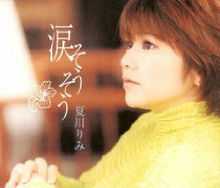 | |||||||||||||
| Single by Rimi Natsukawa | |||||||||||||
| from the album Minamikaze and Tida: Tida Kaji nu Umui | |||||||||||||
| B-side | Anata no Kaze, Hana ni Naru (Acoustic Version) | ||||||||||||
| Released |
March 23, 2001 March 23, 2004 (special edition) | ||||||||||||
| Genre | J-pop, Shima uta | ||||||||||||
| Length | 4:21 | ||||||||||||
| Label | Victor Entertainment | ||||||||||||
| Rimi Natsukawa singles chronology | |||||||||||||
| |||||||||||||
| |||||||||||||
A year after Begin's version, the song was covered by Okinawan singer Rimi Natsukawa as her third single. Her version caused the song to become extremely popular, and is the only version to break the top 10. The song was used in commercials for Japan Post Holdings from 2007 onwards.[6]
Natsukawa first heard the song from the broadcast of the 26th G8 summit held in Okinawa, where Begin had sung the song, and found she could not get the melody out of her head. She requested she cover the song backstage at a Begin concert, to which the band composed the song "Anata no Kaze" for her. She still preferred Nada Sōsō, however, and released both songs her third single.[7]
Due to the song's popularity, it became the focus of the "Nada Sōsō Project" by Japanese television company TBS.[8] The project consists of two dramas released in 2005, "Hiroshima Showa 20 nen 8 Gatsu Muika" and "Nada Sōsō Kono Ai ni Ikite" (涙そうそう この愛に生きて Living in This Love), and a film "Nada Sōsō" in 2006. Natsukawa's version was used for "Hiroshima Showa 20 nen 8 Gatsu Muika" and "Nada Sōsō," while Moriyama's was used for "Nada Sōsō Kono Ai ni Ikite".
Two B-sides feature on the single. The first, "Anata no Kaze" (あなたの風 Your Wind), was also written by Begin. The second, "Hana ni Naru (Acoustic Version)" (花になる(アコースティック・ヴァージョン) Become a Flower), is an acoustic version of her previous single. A special version of the single, limited to 30,000 copies, was released in 2004, collecting the four main versions of the song (standard, Okinawan language version, special Moriyama/Begin/Natsukawa live version, instrumental track).
The Rimi Natsukawa version of the song has been certified as a triple platinum ringtone by the RIAJ, as well as a platinum cellphone download.[9][10]
Track listing
Standard edition (2001)
| No. | Title | Writer(s) | Arranger | Length | |
|---|---|---|---|---|---|
| 1. | "Nada Sōsō" | Begin, Ryoko Moriyama | Seiichi Kyoda | 4:21 | |
| 2. | "Anata no Kaze (あなたの風 Your Wind)" | Begin | Seiichi Kyoda | 4:23 | |
| 3. | "Hana ni Naru (Acoustic Version) (花になる(アコースティック・ヴァージョン) Become a Flower)" | Mami Takubo, Takashi Tsushimi | Chuei Yoshikawa | 4:57 | |
| 4. | "Nada Sōsō (Instrumental Version)" | Begin, Ryoko Moriyama | Seiichi Kyoda | 4:20 | |
| 5. | "Anata no Kaze (Instrumental Version)" | Begin | Seiichi Kyoda | 4:21 | |
Total length: |
22:23 | ||||
Special edition (2004)
| No. | Title | Arranger | Length | |
|---|---|---|---|---|
| 1. | "Nada Sōsō" | Seiichi Kyoda | 4:20 | |
| 2. | "Nada Sōsō (Uchinaaguchi Version)" | Chuei Yoshikawa | 4:18 | |
| 3. | "Nada Sōsō (Special Live Version) (with Begin, Rimi Natsukawa)" | 4:25 | ||
| 4. | "Nada Sōsō (Instrumental Version)" | Seiichi Kyoda | 4:20 | |
Total length: |
23:43 | |||
Chart Rankings[4]
The single is one of the slowest and steadiest selling singles in Japanese history. It began charting in late May 2002, and charted constantly until November 2007. it broke the top 50 in June 2002, and the top 20 in July. From there, it charted between #20-#50 until January 2003. After a performance at the 53rd Kōhaku Uta Gassen, the song reached #8. It stayed within the top 40 until June. The single charted steadily until next year's Kōhaku Uta Gassen, where Natsukawa, Begin and Ryoko Moriyama performed the song together. The single reached #8 again, and stayed within the top 40 until March. The single still continued to chart slowly, between #50 and #200 before breaking the top 50 once again in 2006, after the release of the Nada Sōsō film.
| Release | Chart | Peak Position | First Week Sales | Sales Total | Chart Run |
|---|---|---|---|---|---|
| March 23, 2001 March 23, 2004 |
Oricon Daily Singles Chart | ||||
| Oricon Weekly Singles Chart | 8 54 |
1,930 2,615 |
683,908 9,411 |
232 weeks 9 weeks | |
| Oricon Yearly Singles Chart | 87 (2002) 21 (2003) 58 (2004) |
Other cover versions
The song has become a standard for Okinawan folk music, Enka, choir and instrumental musicians. The song has been recorded in cello, erhu, harmonica, harp, guitar, koto, music box, piano and violin versions, amongst others. It has also been covered by overseas artists, such as Hawaiian Kealiʻi Reichel (as "Ka Nohona Pili Kai" in Hawaiian) and New Zealander Hayley Westenra, who sung a classical crossover rendition in English, and Memory (as Nunmulee Naeyo (눈물이 나요) in Korean). Two versions in Chinese exist: one by Taiwanese Huang Pin-Yuan (as "Bai Lu Si (Chinese: 白鷺鷥; Pe̍h-ōe-jī: Pe̍h-lêng-si White Heron)") in Taiwanese), and one by Joi Chua (as "Pei Wo Kan Ri Chu (陪我看日出 Watching the Sunrise with Me)". In Cambodia, this song covered in Khmer by Sokun Nisa and during CJCC Kizuna Festival Saori Kawabata, Narumi Ii, Kenta Tanahara, Taiki Tokuda and Cambodian musicians jointed perform this song at night as its original Japanese song.
- Alan (2009, album "My Life" DVD)
- Tsutomu Aragaki (2005, album "Nuchi du Takara, Okinawa no Kokoro, Heiwa no Inori")
- Teresa Bright (2007, album "Hawaiinawa")
- Cao Xuejing (2003, album "Shima Uta Erhu")
- Joi Chua (2004, album "Sunrise")
- Marié Digby (2009, album "Second Home")
- Taimane Gardner (2005, album "Loco Princess")
- Naoki Gushiken (B-SHOP) (2003, Begin tribute album "Let's Begin!: Omoto-take O Songs")
- Huang Pin-Yuan (2002, album "Jian Dian Qing Ge")
- Infinix (2005, album "Relaxation Asia III: Chikyū no Nami")
- Hiroshi Itsuki (2003, album "Cover & Self Collection: Ofukuro no Komoriuta")
- Ji Ma Ma (2006, album "Kazedayori")
- Juleps (2008, album "Tabidatsu Hi")
- Tokiko Katō (2003, album "Okinawa Jōka")
- Mirei Kitahara (2004, "Love Songs")
- Yōko Masaki (2003, album "Yōko Masaki Zenkyokushū")
- Takeshi Matsubara (2006, album "Sakurabashi kara")
- Memory (2008, EP "She Dreamed that She Was Flying Like a Bird")
- Kanako Minami (2006, album "Kanako no Hajimete no Album")
- Akemi Misawa (2003, single "Tsumugi Koi Uta" B-side)
- Nozomi Miyanishi (2003, album "Chotto Hitori Koto")
- Kaori Mizumori (2003, album "Kayōkikō II: Tottori Sakyū")
- Shinichi Mori (2009, album "Love Music")
- Haruko Nakamura (2003, album "Haruko")
- Shōhei Naruse (2003, album "Shōhei no Omoroi Uta no Sekai")
- Takashi Obara (2003, album "Takashi Obara Best")
- Kealiʻi Reichel (2005, album "Scent of the Islands, Scent of Memories")
- Fuyumi Sakamoto (2004, album "Yōko Masaki Zenkyokushū")
- Yōko Sei (2004, album "Hana to Hoshi to Ai to: Kokoro Furueru Uta")
- Yoshio Tabata (2003, album "Shima Uta 2: Yoshio Tabata")
- Chisako Takashima (2003, album "Around the World")
- Yoshimi Tendo (2005, album "Smile")
- Atsuko Tenma (2005, album "Nemu no Ki no Komoriuta")
- Hideaki Tokunaga (2005, album "Vocalist")
- Twelve Girls Band (2005, album "The Best of Covers")
- Naori Uchida (2005, album "Stylish: Love & Favourite Songs")
- Hayley Westenra (2007, album "Hayley sings Japanese Songs")
- Yanawaraba (2008, album "Nagi Uta")
- Kazuha Yasuda (2003, compilation album "Yūsen Enka Best 16")
- Yilana (2005, album "Birei-teki Ōsōgen")
- Tōru Yohana (2003, compilation album "Ryūkyū Shika")
- Sokun Nisa (2008, Khmer Version in album "RHM CD VOL 342")
References
- ↑ "「涙そうそう・あなたが好きで」~TIME IS LONELY~". Oricon. Retrieved 2010-01-25.
- ↑ "インタビュー 『涙そうそう』長澤まさみ、妻夫木聡、撮影現場(沖縄)クランクアップ取材". Yahoo. Retrieved 2010-01-25.
- ↑ "涙そうそう 夏川りみ 歌詞情報 - goo 音楽". Retrieved 2010-01-25.
- ↑ 4.0 4.1 4.2 "オリコンランキング情報サービス「you大樹」". Oricon. Retrieved 2010-01-25. (subscription only)
- ↑ "スシャル/イベント情報". Marvelous Entertainment. Retrieved 2010-01-25.
- ↑ "Biography". Rimi Natsukawa Official Site. Retrieved 2010-01-25.
- ↑ "夏川りみ - bounce.com インタビュー". Bounce. Retrieved 2010-01-27.
- ↑ "TBSテレビ放送50周年「涙そうそうプロジェクト」". TBS. Retrieved 2010-01-25.
- ↑ レコード協会調べ 4月度有料音楽配信認定<略称:4月度認定> [Record Association report: April digital music download certifications (Abbreviation: April Certifications)]. RIAJ (in Japanese). May 20, 2011. Retrieved May 20, 2011.
- ↑ レコード協会調べ 10月度有料音楽配信認定<略称:10月度認定> [Record Association report: October digital music download certifications (Abbreviation: October Certifications)]. RIAJ (in Japanese). November 20, 2010. Retrieved May 20, 2011.
External links
- Nada Sōsō at the Internet Movie Database

